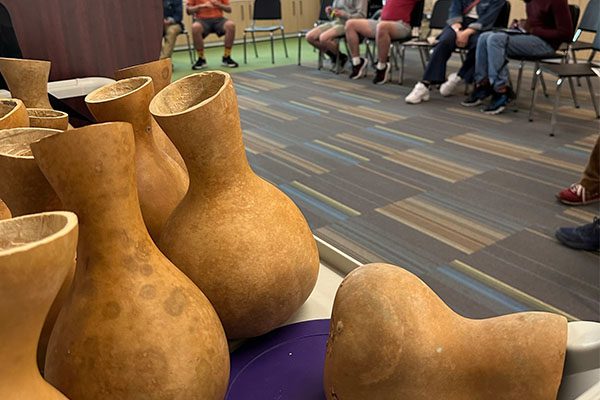Gourds are famously associated with fall decorations and Thanksgiving dishes, but very rarely are they associated with music. However, in Hawaiian culture, an ipu (ee-poo), is a gourd that is often made into a drum.
“Ipu are vegetables, like a squash or a pumpkin, and a drying process hardens them so that they can take the force of hitting them to make music,” said Nadia Castagna, music teacher at The New England Center for Children (NECC). “The ipu is handheld, and the other hand strikes the drum to create a sound. To strike the ipu, musicians use their open hand on the bottom of the ipu, and on the side.”
In native Hawaiian culture, ipu have a special significance as it is said to embody the akua (Hawaiian word for God) Lono and is considered to be the body form of Lono. Ipu are an important, cultural, and historic part of the Hawaiian culture as they are used not only in everyday life, but most importantly, they are used to make kani (sound) and rhythms, for mele (song), and hula (dance).
Castagna was introduced to ipu drums through one of her best friends and a co-worker at Berklee Institute for Accessible Arts Education (where she works on Saturdays), who has Hawaiian heritage and frequently visits the islands. “He is the one that introduced me to Hawaiian culture and music, and I fell in love with the ipu,” she shared.
When COVID forced NECC to move to remote learning in April 2020, Castagna decided to amplify her curriculum to incorporate world music. “Since we were all quarantined, I figured that we could travel vicariously through these lessons to different countries and learn about their music and dance culture. I concluded that in order to make the lessons as authentic as I could, it would be important for me to collaborate with and interview my colleagues that have a heritage based in the countries we were visiting,” she explained.
After teaching a unit on Hawaiian music several times with no ipu, Castagna decided to investigate how to obtain some for NECC. Her colleague introduced her to a farm in California who grows and sells ipu for art and music purposes. Castagna ordered some, and she and her husband used a table saw to cut off the tops (it has to be at a certain height above the neck of the gourd to produce a beautiful hollow sound) and a beveling tool to scoop out as much of the insides as they could (the rest of the insides fall out over time). She decided not to finish the drums with lacquer on the outside, as there is a risk that it may change the sound or make the outside sticky or slippery.
Castagna said she ordered 20 ipu, which were introduced to her NECC classes this spring. “I have found them to be one of the most accessible instruments that we use at NECC,” she shared, adding that an “accessible instrument” refers to one that is easy to use, accommodative to user needs, and can produce immediate feedback. “Playing the ipu is similar to a clapping motion in its most basic form, so producing a sound on the Ipu doesn’t take much.”
She said the response to the ipu has been “fabulous,” as students and teachers alike have been interested in the process of making an ipu drum, and the students have been very excited to play a “vegetable drum.”
“It’s been very satisfying to get to provide this instrument in music class at NECC, as this is an instrument that is not commonly seen outside of hula troupes in and around Hawaii,” Castagna shared. “I’m not sure if we are the only school on the East Coast that has a classroom set of ipu, but I do know that we are at least one of the only schools on the East Coast to have a set, which makes it even more exciting to explore the new opportunities that these instruments bring.”
Even though students are back to learning in person in the classroom, Castagna believes it’s important to incorporate music and instruments from different cultures. “The students at NECC deserve to have a diverse music education that is a collaborative effort among the members of their community,” she shared, adding that students have started asking about new instruments from the countries they have studied, and some have started independently navigating world music sections on iTunes. “It is important to have cross-cultural learning as it shows how other cultures express themselves and communicate through music. Music is such an integral part of life and is pervasive in every society. By having students learn about music, it teaches them to appreciate the beauty of other cultures.”

